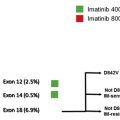Although benign hemangiomas are among the most common diagnoses among connective tissue tumors, angiosarcomas and other sarcomas arising from blood vessels are rare, even among sarcomas. Because endothelial tumors have unique embryonal derivation compared with other sarcomas, it is not surprising they have unique characteristics. Herein are reviewed some of these unique characteristics and therapeutic options for patients with some of these diagnoses, highlighting the potential of new agents for these tumors, which will in all likelihood also impact treatment on more common cancers.
Key points
- •
Vascular sarcomas are rare and collectively affect fewer than 600 people a year in the United States (incidence approximately 2/million).
- •
Because angiosarcomas, hemangioendotheliomas, and other vascular tumors have unique embryonal derivation, it is not surprising that they have a unique sensitivity pattern to chemotherapy agents.
- •
Surgery, when possible, remains the primary treatment for angiosarcomas.
- •
Adjuvant radiation for primary disease seems prudent for at least some angiosarcoma, given the high local-regional recurrence rate of these tumors. Angiosarcomas also have a high rate of metastasis, but it is not clear that adjuvant chemotherapy improves survival.
- •
Epithelioid hemangioendothelioma is a unique form of sarcoma often presenting as multifocal disease. Most patients can do well with observation alone, although a fraction of patients have more aggressive disease and have difficulties in both local control and metastatic disease.
- •
Anthracyclines, alkylating agents such as ifosfamide, are active against at least some vascular sarcomas. Angiosarcomas demonstrate a unique sensitivity to taxanes, and gemcitabine, vinorelbine, and vascular endothelial growth factor (VEGF) or vascular endothelial growth factor receptors (VEGFR) antagonists all have at least some activity against these tumors.
- •
New targets to consider for therapy include angiopoietin antagonists as well as inhibitors notch or ephrin signaling pathways.
Stay updated, free articles. Join our Telegram channel

Full access? Get Clinical Tree





